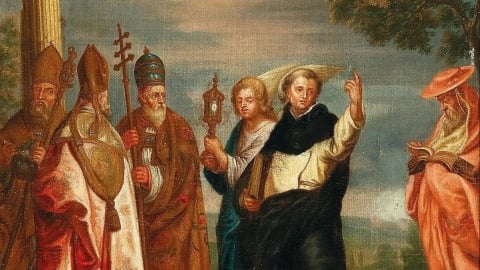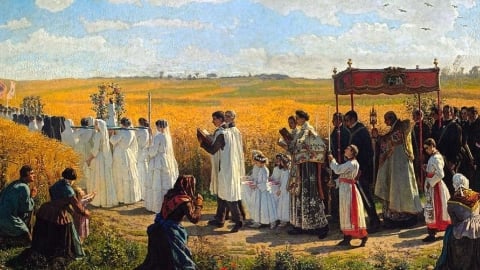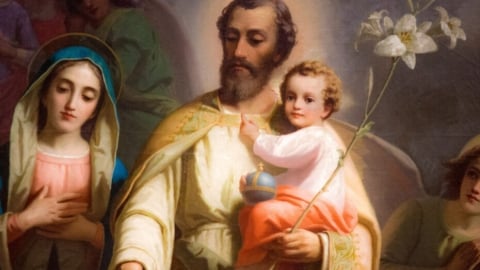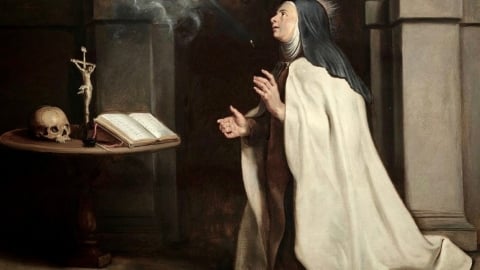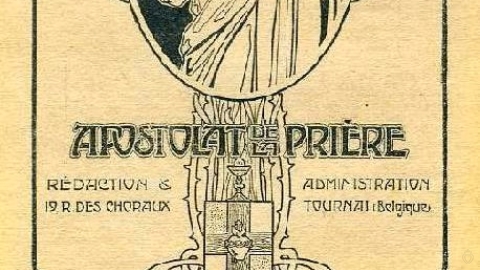The Place of the Precious Blood in the Spiritual Life

It is a commonplace that the frequently occurring cloys the inquiring mind. The infrequent rainbow will stir the soul to its depths, the ever-recurring sunrise leave it cold and unaroused. But, who will say that the bow in the skies outshines the brilliance of the early dawn! Even so in the spiritual life, it is often enough the unusual rather than the solid doctrine that attracts our moth-like, unstable souls. The sure cure for this human weakness is frequent meditation on the fundamentals of our Faith. The many facets of the Catholic jewel must be examined up-close. Our goal must be not knowledge, but realization. As the author of the Spiritual Exercises puts it: “it is not an abundance of knowledge that fills and satisfies the soul, but to feel and taste things internally.”
The purpose of this essay is to set forth a few doctrinal observations concerning the Precious Blood, in the hope that frequent meditation on them may enkindle within our hearts a great devotion to that red stream of divine love which wrought our salvation.
It is a dogma of our Faith that the Son of God assumed as His very own a complete human nature. This is a fundamental principle in considering the Precious Blood. Scientists tell us that the bloodstream is devoid of life. Hence, did we not have the defined truth that the Word possessed a complete and integral human body, we might wonder concerning the union that exists between the Precious Blood and the Son of God become Man. But our Faith teaches that the Word assumed not only flesh and soul, but also the human blood-stream.
Scripture speaks of the flesh and blood of our Lord in the same terms: “Therefore because children have blood and flesh in common, so he in like manner has shared in these; that through death he might destroy him who had the empire of death, that is, the devil; and might deliver them, who throughout their life were kept in servitude by the fear of death” (Hebrews 2:14-15). Again we read: . . . the Church of God, which he has purchased with his own blood” (Acts 20:28). St. Peter writes: “You know that you were redeemed from the vain manner of life handed down from your fathers, not with perishable things, with silver or gold, but with the precious blood of Christ as of a lamb without blemish and without spot” (I Peter 1:18-19). Scripture, then, is too explicit to allow any doubt about the intimate union between the Precious Blood and the Person of the Word.
We have it, therefore, on the word of God that our salvation was accomplished by the Blood of the Lamb. To this Blood is ascribed an infinite value, for the notion of redemption and satisfaction as effected by Jesus Christ is inseparably linked with infinite value. Now, if to the Blood in itself is attributed the infinite price of our redemption, this is possible only if the Blood is hypostatically, or personally, united to the Person of the Son of God.
From the words of several General Councils defining that our Lord had a complete and integral human body, from the testimony of Scripture which attributes our salvation to the Precious Blood (the Scriptural testimony was repeated by Clement VI in his Jubilee Bull of 1349), we may conclude that to the Precious Blood may be accorded the same worship that is offered to the Sacred Heart of Jesus. For both were personally united to the Son of God.
Let us turn to the Mass. When the priest at the altar says those memorable words, “for this is the chalice of my blood” and so forth, what really happens? To answer this, we must go back to the Last Supper, for what Jesus did at the Supper the priest does at the Mass. When, on that most solemn evening, Jesus took the cup of wine into His holy and venerable hands and said: “All of you drink of this; for this is my blood of the new covenant, which is being shed for many unto, the forgiveness of sins” (Luke 26:2), what really took place? Now, Jesus, as the Son of God, can tell naught but the truth. When, therefore, He said, “this is my blood,” a great and wonderful change took place, the one and only event of its kind in the history of the world up to that time. What He held in His hands, after these words, was no longer wine. No, it was a cup that contained His most Precious Blood. Beneath the appearances of wine was contained, as the Council of Trent teaches, Christ's own Blood-and with the Blood, His Body, Soul, and Divinity.
At the Supper the Blood was shed mystically or symbolically by the separate consecration of the wine and bread. By this the bloody death of the morrow was symbolized. At the Mass the same holds true, for the Mass reenacts what Christ did at the Supper. The Mass and the Supper are, after the rite of Melchisedech, an unbloody sacrifice; the sacrifice of the Cross is according to the rite of Aaron, a bloody sacrifice.
After the Supper, Jesus continued to offer Himself to His eternal Father. The bloody sweat in the Garden, the scourging, the crowning with thorns-all were outlets for that great sacrificial stream of love in the red current of which the sins of the world were swept away as driftwood in a swollen river. Then on Calvary, in a sublime finale of divine love, the Sacred Heart was emptied of that most precious burden, the cleansing Blood of the immaculate Lamb of God. In this bloody consummation of the Savior's sacrifice our redemption was achieved. It but required the extrinsic acceptance on the part of God, that the sacrifice be forever complete. By the Resurrection the Precious Blood was again united to the Sacred Body and in the Ascension Jesus was taken into Heaven, where, as “the Lamb that was slain,” He forever pleads our cause.
In the Mass, as the Council of Trent teaches, we have the same sacrificial Victim as was immolated on Golgotha; and the same One now offers by the ministry of priests, Who then offered Himself on the Cross, the sole difference being in the manner of offering. No longer is the Precious Blood drained from the Sacred Heart, but forever will that red current flow through the living Body of Jesus. In the Mass, as at the Supper, there is the mystical, or symbolical, shedding of the Blood in the separate consecration of wine. The species of wine, in its sacramental signification, more directly signifies the Precious Blood; although, of course, we must hold that the whole Christ is (equally) present under the sacramental veil of either species.
In our spiritual life, then, it is clear what an important role devotion to the Precious Blood should play. The spiritual life is possible only through Grace. Grace, however, is had only through tapping the great reservoir of the merits of Christ. And the merits of Christ have been won by the shedding of His Precious Blood on the altar of the Cross. From His pierced Sacred Heart poured forth the scarlet laver that satisfied for our sins, redeemed all men, merited grace by which we are justified. Indeed, we have been redeemed at a great price. Would that we could all “feel and taste internally” those words of St. Peter: “You know that you were redeemed. . .. not with perishable things, with silver or gold, but with the precious blood of Christ.”
